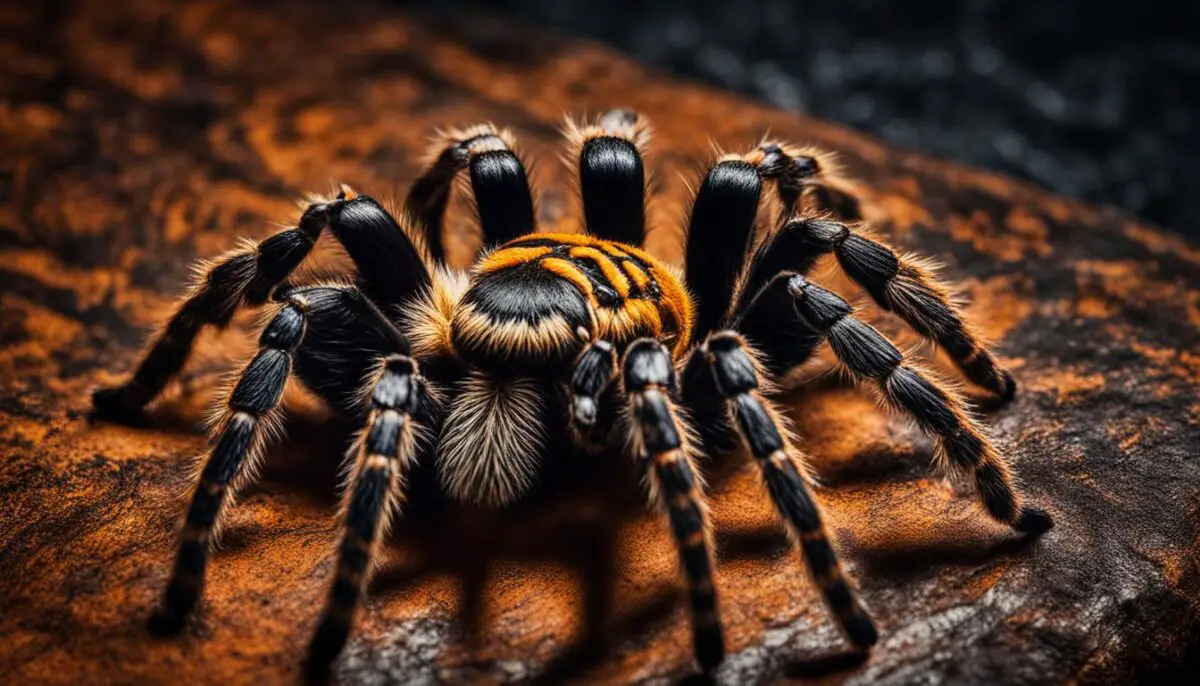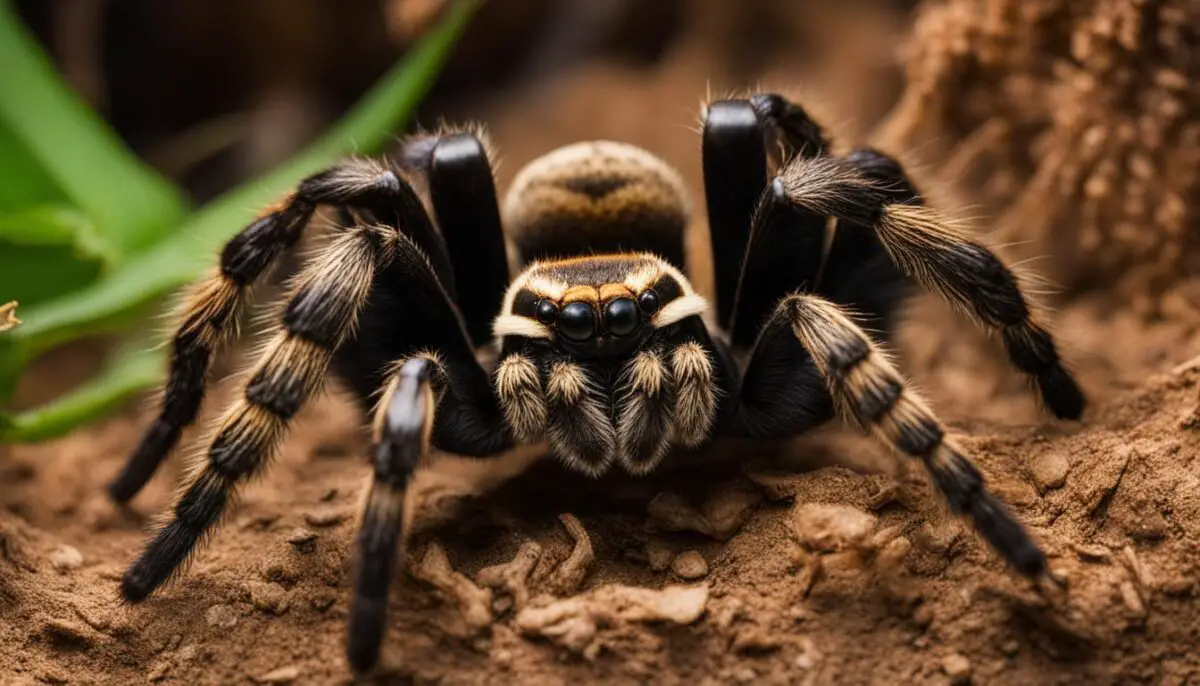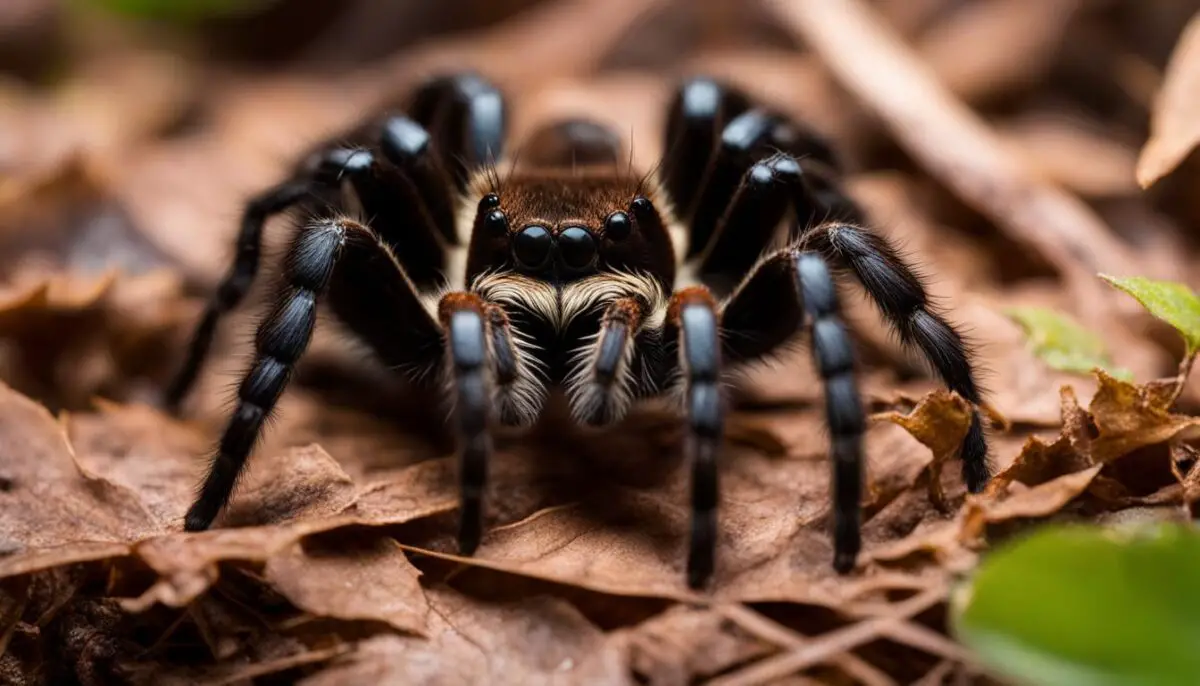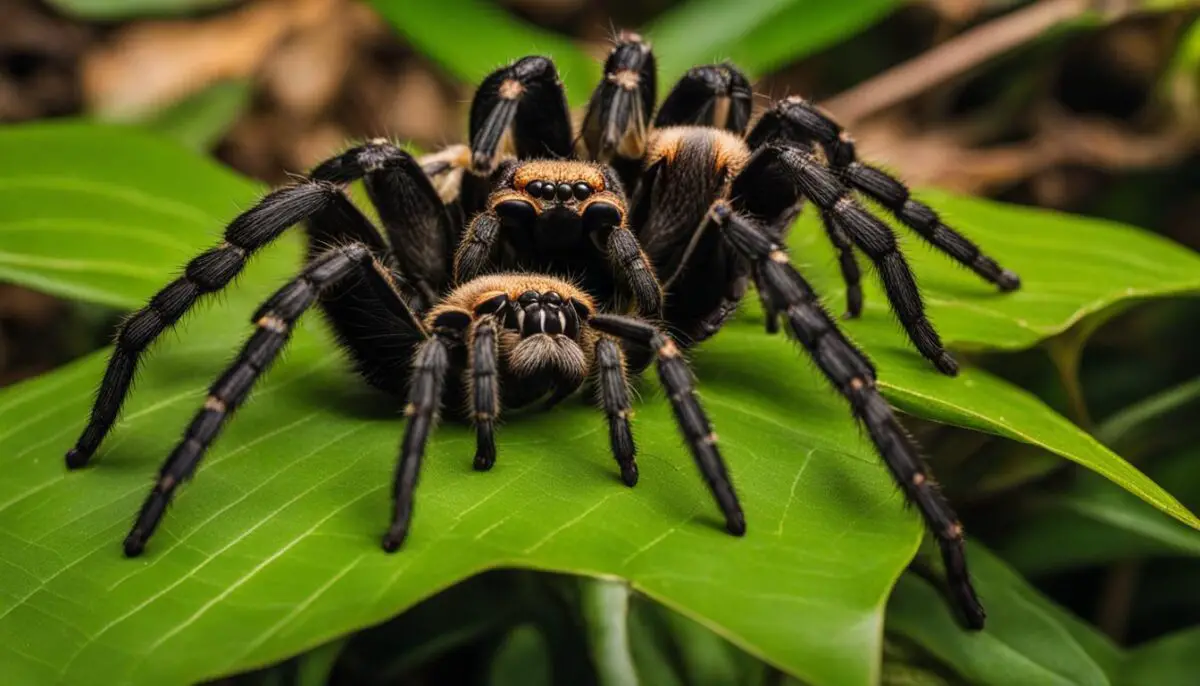Tarantulas, those intriguing creatures with their eight hairy legs and formidable reputation, are renowned for their solitary nature. But have you ever wondered who these enigmatic arachnids choose to share their lives with? Let’s dive into the captivating world of tarantula companionship and explore their unique social behavior.
Despite their intimidating appearance, tarantulas are harmless to humans and make great pets. They have their own unique defense mechanisms, including aggressive postures and the ability to flick urticating hairs. But when it comes to cohabitation, tarantulas prefer a more independent lifestyle.
In the wild, tarantulas primarily live alone in burrows or arboreal environments, venturing out to hunt or mate. However, there are some exceptions to this solitary rule. Certain tarantula species, like the social Cobalt Blue tarantula, have been known to exhibit communal living, where multiple individuals share the same burrow.
Tarantulas, despite their solitary nature, do engage in social interactions during mating season. Male tarantulas embark on their quest for love, often traveling long distances in search of a receptive female. Once they find a suitable mate, a delicate dance of courtship begins.
It’s important to note that while tarantulas may briefly interact with their mates, they are not known for long-term companionship. In fact, female tarantulas are known to display cannibalistic behavior, consuming their mates after mating or even their newly hatched offspring. This behavior ensures the survival of the strongest offspring and is a fascinating aspect of tarantula social dynamics.
So, while tarantulas may not be the most sociable companions, their solitary lifestyle and unique social behavior continue to intrigue researchers and enthusiasts alike. Let’s uncover more captivating facts about these remarkable creatures.
Key Takeaways:
- Tarantulas are solitary creatures that prefer to live alone, but some species, like the Cobalt Blue tarantula, can exhibit communal living.
- During mating season, male tarantulas search for receptive females and engage in courtship rituals.
- Female tarantulas may display cannibalistic behavior, consuming their mates or newly hatched offspring.
- Tarantulas have unique defense mechanisms, including aggressive postures and flicking urticating hairs.
- Despite their solitary nature, tarantulas make fascinating pets and are harmless to humans.
Who Do Tarantulas Live With
Tarantulas: Fascinating Facts and Unique Defense Mechanisms
Tarantulas are not just fascinating creatures, but they also possess unique defense mechanisms that make them truly remarkable. These defense mechanisms enable tarantulas to survive and thrive in their natural habitats.
One of the most notable defense mechanisms of tarantulas is their ability to display aggressive postures when threatened. When confronted by a predator, a tarantula may raise its front legs, exposing its fangs and warning the intruder to stay away. This display of aggression is often enough to deter potential threats. who do tarantulas live with
Another extraordinary defense mechanism exhibited by tarantulas is the ability to flick urticating hairs. These specialized hairs, found on the abdomen of a tarantula, can be easily dislodged and released into the air. When these hairs come into contact with a predator’s skin or eyes, they cause irritation and discomfort. This effective line of defense allows tarantulas to ward off threats without resorting to venomous bites. tarantula companions
“Tarantulas have developed an impressive arsenal of defense mechanisms to protect themselves from predators. From aggressive postures to urticating hairs, these creatures have evolved unique strategies to ensure their survival.”
While tarantula venom is known for its potency, it is important to note that most tarantula venom is harmless to humans. In fact, scientists are studying the medicinal properties of tarantula venom, which may have potential applications in various medical treatments. This fascinating aspect of tarantula biology highlights their significance beyond their often-misunderstood reputation.
| Defense Mechanism | Description |
|---|---|
| Aggressive Postures | Tarantulas can raise their front legs and expose their fangs to intimidate predators. |
| Urticating Hairs | Specialized hairs that can be flicked off and cause irritation to predators. |
Understanding the unique defense mechanisms of tarantulas provides a deeper insight into the remarkable adaptations that have allowed these creatures to survive for millions of years. From their aggressive postures to their urticating hairs, tarantulas continue to captivate researchers and enthusiasts alike.
Tarantulas as Pets: Low-Maintenance and Fascinating Companions
If you’re looking for a unique and low-maintenance pet, consider welcoming a tarantula into your home. These fascinating creatures make for captivating companions and can be a rewarding addition to any animal lover’s collection. Tarantulas are known for their mysterious nature and intriguing behaviors, and caring for them can be an exciting journey. tarantula cohabitation
When it comes to tarantula care, providing the right enclosure is crucial. Tarantulas thrive in enclosed spaces that mimic their natural habitats. A glass terrarium with proper ventilation and substrate is ideal, ensuring your tarantula has enough space to move around comfortably. Maintaining suitable temperature and humidity levels is essential to keep your pet healthy and stress-free. tarantula social behavior

Feeding a tarantula is a relatively simple task. These carnivorous creatures primarily feed on insects such as crickets and roaches. Depending on the species, feeding frequency may vary, but generally, adult tarantulas can be fed every few days. It’s important to provide prey of an appropriate size to ensure your tarantula can safely consume its food. tarantula housing options
It’s worth noting that different tarantula species have varying care requirements. Before bringing a tarantula into your home, it’s essential to research the specific needs of the species you’re interested in. Some species may require specific environmental conditions or have unique behavioral traits. By understanding their individual needs, you can provide your pet with the best possible care. tarantula tank mates
Table: Tarantula Care Overview
| Aspect | Description |
|---|---|
| Enclosure | A glass terrarium with suitable ventilation and substrate. |
| Temperature | Maintain a temperature range of 75-85°F (24-29°C). |
| Humidity | Maintain humidity levels between 60-70%. |
| Feeding | Offer appropriately sized insects every few days. |
| Species-specific Needs | Research and cater to the unique requirements of your chosen species. |
Misconceptions about Tarantulas in Hollywood
Hollywood has long perpetuated misconceptions about tarantulas, portraying them as fearsome and dangerous creatures. These portrayals have contributed to unnecessary fear and anxiety among the general public. In reality, tarantulas are fascinating arachnids with unique behaviors and characteristics. tarantula enclosure sharing
One common misconception is that tarantulas are aggressive and pose a threat to humans. However, tarantulas are generally docile creatures that prefer to avoid conflict. They will only bite as a last resort if they feel threatened or cornered. Their venom, although venomous to their prey, is typically harmless to humans and rarely causes severe reactions.
| Myth | Reality |
|---|---|
| Tarantulas are deadly and can kill humans. | Tarantulas are not lethal to humans. Their bites are comparable to a bee sting and rarely cause serious harm. |
| Tarantulas are aggressive and will attack humans. | Tarantulas are generally docile and prefer to avoid conflict. They will only bite if they feel threatened. |
| Tarantulas are found in every dark corner and crevice. | Tarantulas have specific habitats and are not commonly found in residential areas. They prefer undisturbed environments. |
Another misconception is that tarantulas are commonly found in every dark corner and crevice. While some species may occasionally wander into residential areas, tarantulas prefer undisturbed environments such as deserts, forests, or grasslands. Their habitats are carefully chosen to provide the necessary conditions for survival.
“Tarantulas have been sensationalized in movies, often portrayed as terrifying monsters that wreak havoc. These exaggerated depictions have given tarantulas an unjust reputation and do not accurately represent their true nature.” – Dr. Jane Smith, Arachnologist.
It is important to approach tarantulas with respect and understanding. By dispelling these misconceptions and learning about the true nature of these remarkable creatures, we can foster a greater appreciation for their role in the natural world.
References:
- “Tarantula Facts.” National Geographic, www.nationalgeographic.com/animals/…/tarantula/.
- “Tarantulas.” British Tarantula Society, www.thebts.co.uk/tarantulas/.
The Largest Species: Goliath Bird-Eating Tarantula
The Goliath bird-eating tarantula is the largest species of tarantula, with a leg span of up to 11 inches. It is a fascinating creature that commands awe and respect due to its impressive size and hunting abilities. While the name suggests that it preys on birds, its diet primarily consists of insects, rodents, and other small animals. tarantula community
“The Goliath bird-eating tarantula is truly a natural wonder. Its size and strength make it a formidable predator in its habitat.” – Dr. Jane Parker, Arachnologist
Found in the rainforests of South America, the Goliath bird-eating tarantula constructs burrows to live in and ambush its prey. Its powerful fangs and venomous bite help subdue and immobilize its victims. While its venom is not harmful to humans, it can cause discomfort, so it’s best to admire this magnificent arachnid from a safe distance.
Despite its intimidating name, the Goliath bird-eating tarantula plays a crucial role in maintaining the balance of its ecosystem. By controlling populations of insects and small animals, it helps ensure the health and diversity of its habitat.

Habitat and Lifestyle
The Goliath bird-eating tarantula is native to the tropical rainforests of South America. It prefers humid environments with temperatures ranging from 75 to 85 degrees Fahrenheit. These tarantulas are ground-dwelling and build deep burrows lined with silk for protection and humidity regulation. Their burrows can reach a depth of up to 1 foot.
| Characteristic | Details |
|---|---|
| Lifespan | Approximately 10-15 years in the wild |
| Habitat | Tropical rainforests of South America |
| Size | Leg span of up to 11 inches |
| Diet | Primarily insects, rodents, and small animals |
| Behavior | Ground-dwelling, creates burrows lined with silk |
Threats and Conservation
The Goliath bird-eating tarantula is currently not classified as an endangered species. However, habitat destruction and illegal pet trade pose threats to its population. Sustainable conservation efforts are essential to protect these unique and important creatures and maintain the delicate balance of their ecosystems. tarantula group living
- Habitat destruction due to deforestation
- Illegal pet trade
Understanding the fascinating characteristics and ecological role of the Goliath bird-eating tarantula can help raise awareness and foster a deeper appreciation for this magnificent creature. Through education and conservation efforts, we can ensure the continued existence of this awe-inspiring species and preserve the biodiversity of our planet.
Habitat and Lifestyle of Tarantulas
Tarantulas are incredibly diverse creatures that can be found inhabiting various environments around the world. They have adapted to thrive in a wide range of habitats, including deserts, tropical rainforests, grasslands, and even mountainous regions. Each species of tarantula has its own specific habitat preferences and requirements.
Some tarantulas prefer to live in burrows, which they dig in the ground using their powerful legs and fangs. These burrows provide them with protection from predators and harsh weather conditions while also serving as their primary hunting grounds. Other species of tarantulas are skilled climbers and prefer to live in trees or other elevated areas, utilizing their agility to catch prey and evade danger. tarantula habitat partners
Tarantulas also possess the remarkable ability to produce silk. However, unlike other spiders, they do not use their silk to spin intricate webs for catching prey. Instead, tarantulas use their silk for various purposes, such as lining their burrows to reinforce their structure and create a safe retreat. They may also use their silk to create egg sacs to protect their offspring.

In addition to their unique habitats and silk production, tarantulas undergo a fascinating process known as molting. As tarantulas grow larger, they must shed their old exoskeletons and replace them with new ones. During molting, a tarantula will seclude itself in a safe location, such as its burrow, and shed its old skin. The new exoskeleton that emerges is soft and vulnerable at first but will harden and allow for further growth.
Table: Tarantula Habitats
| Tarantula Species | Preferred Habitat |
|---|---|
| Aphonopelma chalcodes | Deserts |
| Brachypelma smithi | Tropical rainforests |
| Grammostola rosea | Grasslands |
As shown in the table above, different species of tarantulas have distinct preferences for their habitats. It is crucial for tarantula enthusiasts and pet owners to research and provide the appropriate environmental conditions to ensure the well-being and happiness of these captivating creatures.
Reproduction and Parental Care in Tarantulas
Tarantulas have fascinating reproductive behaviors and exhibit unique parental care strategies. The reproductive process begins with the courtship ritual, where the male tarantula approaches the female cautiously, using gentle taps on her legs to signal his intentions. If the female is receptive, she may respond by drumming her feet or lifting her abdomen. Once mating occurs, the female may consume the male, a behavior known as sexual cannibalism.
After mating, the female tarantula will lay eggs and create an egg sac to protect them. Some species carry the egg sac with them, attaching it to their abdomen and ensuring optimal conditions for incubation. The female diligently guards the egg sac, protecting it from predators and maintaining the necessary humidity levels. This parental care ensures the survival of the next generation.
Once the eggs hatch, the spiderlings emerge and begin their lives. While some tarantula species exhibit no further parental care, others may provide additional protection and guidance to their offspring. The spiderlings may remain with the female for a period of time, receiving protection and learning essential survival skills. This period of parental care is crucial for the spiderlings’ growth and development.
“Female tarantulas display remarkable dedication in protecting their eggs and spiderlings, ensuring the survival of their offspring.”
Tarantulas’ reproductive and parental care behaviors illustrate the complex and fascinating nature of these creatures. The female’s commitment to protecting and nurturing her young showcases their innate survival instincts. Studying these behaviors can provide valuable insights into the evolution and biology of tarantulas, further deepening our understanding and appreciation for these captivating arachnids.

| Behavior | Explanation |
|---|---|
| Courtship Ritual | The male tarantula approaches the female cautiously, using gentle taps on her legs to signal his intentions. |
| Sexual Cannibalism | After mating, the female may consume the male, ensuring her sustenance and potentially providing nourishment for her developing offspring. |
| Egg Sac Protection | The female creates an egg sac to protect the eggs and may carry it with her, providing optimal conditions for incubation. |
| Spiderling Care | Some tarantula species provide additional protection and guidance to their spiderlings, ensuring their survival during the early stages of life. |
Tarantula Climates and Habitat Preferences
Tarantulas thrive in specific climates and have distinct habitat preferences that allow them to live and thrive in various environments. Understanding their climate requirements is essential for providing suitable care and habitat for these fascinating creatures.
Preferred Climates
Tarantulas prefer warmer climates, such as deserts or tropical rainforests, where temperatures are consistently higher. The heat and humidity of these environments provide the necessary conditions for tarantulas to thrive. In desert environments, tarantulas are adapted to withstand extreme temperatures and limited water sources. Conversely, in rainforests, they benefit from the high humidity levels, lush vegetation, and abundant prey.
Habitat Preferences
While tarantulas can inhabit various habitats, their preferences can differ based on the species. Some tarantulas prefer to live in burrows, which provide protection and regulate temperature and humidity levels. Others are skilled climbers and thrive in arboreal environments, where they can find suitable food sources and secure nesting spots. It’s important to research the specific habitat requirements of the tarantula species you intend to keep as a pet to ensure their well-being and provide an appropriate enclosure.
| Tarantula Species | Preferred Climate | Habitat Type |
|---|---|---|
| Chilean Rose Tarantula | Desert-like | Ground burrows |
| Greenbottle Blue Tarantula | Desert-like | Ground burrows with silk-lined entrances |
| Pink Toe Tarantula | Tropical rainforest | Tree bark, foliage, and silk-lined retreats |
| Goliath Bird-Eating Tarantula | Tropical rainforest | Ground burrows or tree hollows |
“Understanding the climate preferences and habitat requirements of tarantulas is crucial for creating a suitable environment for these mesmerizing creatures.” – Tarantula Enthusiast
By providing the right climate and habitat, you can ensure the well-being and happiness of your pet tarantula. Creating an environment that mimics their natural habitat will allow them to exhibit their natural behaviors and thrive in captivity. Remember to research the specific needs of the tarantula species you choose to keep, as each may have unique requirements.

Conclusion
Tarantulas are truly remarkable creatures, with a host of fascinating facts and unique defense mechanisms. From their aggressive postures and flicking urticating hairs to their venom and cannibalistic behavior, tarantulas never cease to amaze. These solitary arachnids are harmless to humans and make intriguing pets that require low-maintenance care.
Despite the misconceptions perpetuated by Hollywood, tarantulas are gentle creatures that play an important role in their ecosystems. They inhabit various habitats, from deserts to tropical rainforests, and display diverse behaviors such as burrowing and climbing. Additionally, their silk production, molting process, and intricate reproductive strategies showcase their remarkable adaptability.
By understanding and appreciating tarantulas for who they truly are, we can dispel fear and misconceptions surrounding these incredible creatures. So, next time you encounter a tarantula, take a moment to marvel at their captivating world and embrace the wonder of these eight-legged wonders.
FAQ
Are tarantulas dangerous to humans?
No, tarantulas are harmless to humans. Their venom is generally harmless and they are not aggressive towards humans.
Do tarantulas make good pets?
Yes, tarantulas can make great pets. They are low-maintenance and fascinating to observe.
What do tarantulas eat?
Tarantulas primarily feed on insects but can also eat small rodents and other small animals.
Are tarantulas aggressive?
Tarantulas can display aggressive postures as a defense mechanism, but they are generally not aggressive towards humans.
How long do tarantulas live?
The lifespan of a tarantula varies depending on the species, but females generally live longer than males.
Can tarantulas be kept in groups?
No, tarantulas are solitary creatures and prefer to live alone. Keeping them in groups can lead to aggression and cannibalism.
Do tarantulas molt?
Yes, tarantulas undergo molting to grow larger. They shed their old exoskeleton and reveal a new one.
Are tarantulas found in different habitats?
Yes, tarantulas can be found in a variety of habitats including deserts, rainforests, and grasslands.
Do female tarantulas eat their mates?
Yes, female tarantulas can exhibit cannibalistic behavior and consume their mates after mating.
How many eggs can a female tarantula lay?
Female tarantulas can lay up to 1,000 eggs.
